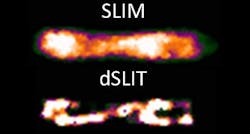3D microscopy technique visualizes sub-cellular structure of E. coli noninvasively
Researchers at the University of Illinois at Urbana-Champaign (Champaign, IL) have created a fast, noninvasive 3D microscopy technique for visualizing, quantifying, and studying cells without the use of fluorescence or contrast agents. In their published work, the researchers reported that they were able to use it to visualize E. coli bacteria.
The technique is based on spatial light interference microscopy (SLIM), which was designed by Beckman Institute researcher Gabriel Popescu as an add-on module to a commercial phase contrast microscope. SLIM is extremely fast and sensitive at multiple scales (from 200 nm and up) but, as a linear optical system, its resolution is limited by diffraction.
By applying a novel deconvolution algorithm to retrieve sub-diffraction limited resolution information from the fields measured by SLIM, Popescu and his fellow researchers were able to render tomographic images with a resolution beyond SLIMâs diffraction limits. They used the sparse reconstruction method to render 3D reconstructed images of E. coli cells, enabling label-free visualization of the specimens at sub-cellular scales.
Last year, the researchers demonstrated a new optical technique that provides 3D measurements of complex fields called spatial light interference tomography (SLIT) on live neurons and photonic crystal structures. In this project, they developed a novel algorithm to further extend the 3D capabilities by performing deconvolution on the measured 3D field, based on modeling the image using sparsity principles. This microscopy capability, called dSLIT, was used to visualize coiled sub-cellular structures in E. coli cells.
The researchers wrote that the method addresses two major issues in cell microscopy: Lack of contrast, due to the thin and optically transparent nature of cells, and diffraction-limited resolution. They write that dSLITâs ability to retrieve limited resolution information delivered by SLIM will give researchers a tool to study structures like E. coli cells in a completely new way, thereby providing novel insights into cellular function.
âAlthough several such structures have been previously identified, little is known about their function and behavior due to the practical difficulties involved in imaging them,â the researchers concluded. âThe results presented here indicate that dSLIT can be used to characterize and study such sub-cellular structure in a practical and noninvasive manner, opening the door for a more in depth understanding of the biology.â
The research team's work has been published in the journal PLoS ONE; for more information, please visit http://www.plosone.org/article/info%3Adoi%2F10.1371%2Fjournal.pone.0039816.
-----
Follow us on Twitter, 'like' us on Facebook, and join our group on LinkedIn
Follow Laser Focus World on your iPhone or Android
Subscribe now to BioOptics World magazine; it's free!

